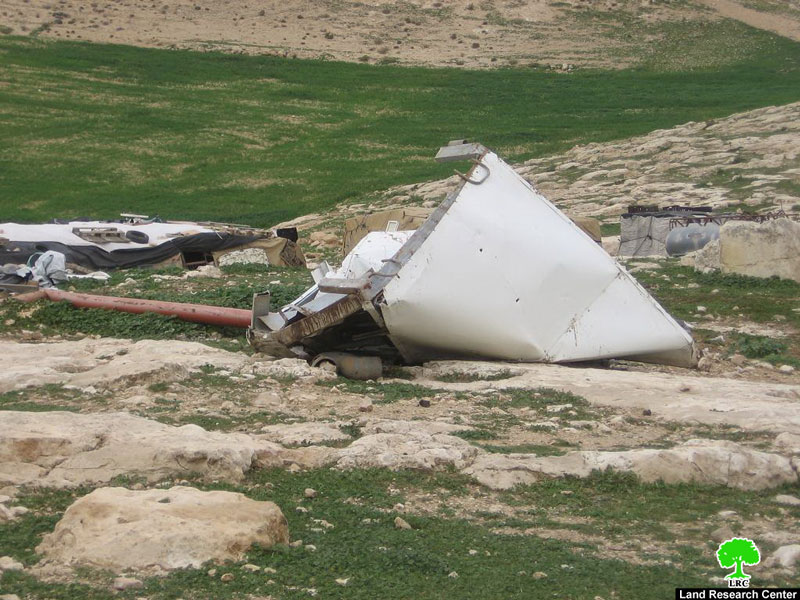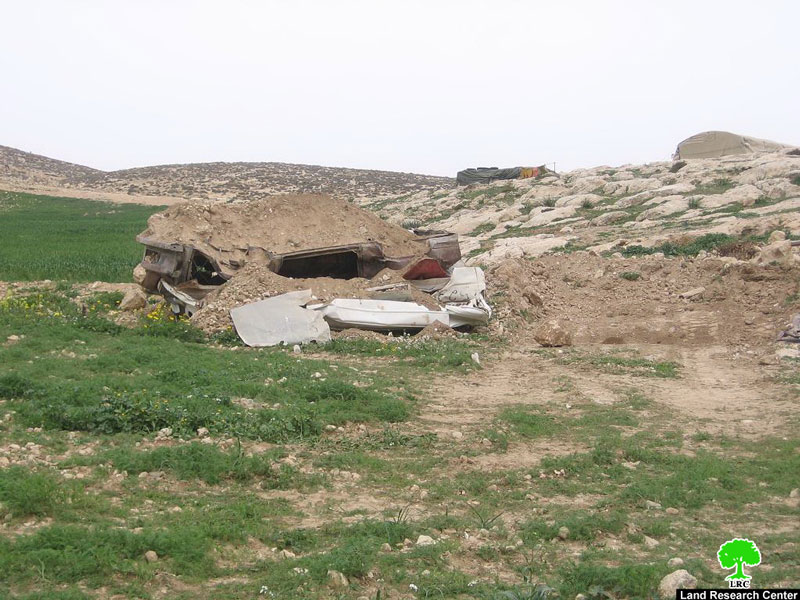Israeli occupation forces demolished on February 13, 2012, shelters and animal pens as well as water cisterns in Khirbet al Rahwa south of the town of Adh Dhahiriya in Hebron Governorate. In accordance with testimonies collected by the Land Research Center (LRC)’s field researcher from the residents of the khirbet, Israeli occupation forces surrounded the khirbet in the early morning hours and started to demolish the targeted structures without giving any chance for the residents to remove their belongings.
The residents pointed out that the occupation forces have issued Stop Work Orders against the structures on May 2011. In turn, the residents provided copies of these Orders to the Municipality of adh Dhahiriya who took some steps in order to prevent the demolition. When the residents confronted the Basic Infrastructure Officer in the so-called “Israeli Civil Administartion” that they did not receive a final demolition order, he said that he came to the khirbet in July 2011 and submitted the said Order. Yet, the residents indicated that they never received such an Order despite the fact they are always present in the khirbet.
Regarding the demolished structures, they included shelters, tents, animal pens, 4 mobile latrines provided by the Spanish organization action against Hunger (ACF) in addition to a water cistern and a number of bee hives. The following tables categorize the damages caused by the demolition process:
A) Shelters: Israeli occupation forces have destroyed a total of 7 shelters.
|
Name
|
Family Members
|
No. of Children
|
Area
(in m2)
|
Construction Year
|
Nature of Structure
|
|
Rateb Ahmad Moh’d Al Omoor.
|
7
|
4
|
60
|
2008
|
Tent and metal pylons
|
|
Saleem Salem Al Till
|
7
|
0
|
60
|
2008
|
Tent and metal pylons
|
|
Ayman Saleem Al Till
|
5
|
3
|
30
|
2008
|
Metal pylons, plastic coverings and wood.
|
|
Nayef Salem Mustafa Al Till
|
8
|
0
|
49
|
2008
|
Tent and metal pylons
|
|
Moh’d Saleem Mustafa Al Till.
|
6
|
4
|
24
|
2008
|
Tent and metal pylons
|
|
Shihda Hamad Moh’d Wreidat
|
6
|
4
|
48
|
2008
|
Tent and metal pylons
|
|
Moh’d Mahmoud Hussein Jabareen
|
5
|
3
|
96
|
2008
|
Tent and metal pylons
|
|
TOTAL
|
44
|
18
|
367
|
|
|
Pic. 1-5: the debris of the demolished shelters
B)Animal pens: Israeli occupation forces have destroyed 7 animal pens.
|
Name
|
Description of Animal Pen
|
Area
(in m2)
|
No. of Sheep
|
Construction Year
|
|
Saleem Salem Al Til
|
Wire fence, metal pylons and a wooden ceiling.
|
200
|
250
|
2008
|
|
Ayman Saleem Al Til
|
Stone walls with plastic covering.
|
120
|
100
|
2008
|
|
Nayef Salem Mustafa Al Til
|
Wire fence with a plastic covering.
|
80
|
100
|
2008
|
|
Rateb Ahmad Al Omoor
|
Wire fence and plastic covering. Total of 2.
|
140
|
150
|
2008
|
|
Mohammad Saleem Mustafa Al Til
|
Metal pylons with plastic covering.
|
70
|
0
|
2008
|
|
Shihdeh Hamad Wreidat
|
Stone walls with plastic covering.
|
100
|
150
|
2008
|
|
Moh’s Mahmoud jabareen
|
Metal pylons with plastic and zinc covering
|
75
|
150
|
2008
|
|
TOTAL
|
785
|
990
|
|
 ll
ll
Pic 6-9: The debris of the demolished animal pens.
C) Mobile Latrines: Israeli occupation forces destroyed 4 bathroom units made of zinc donated earlier by the Spanish organization Action Against Hunger (ACF). The area of each unit is 4 m2.
|
Name of Family Head
|
No. of Beneficiaries
|
|
Saleem Salem Al Til
|
5
|
|
Rateb Ahmad Moha’d Omoor
|
7
|
|
Shihdeh Hamad Wreidat
|
6
|
|
Rajeh Farhan Smamreh
|
5
|
Pic. 10: The debris of the demolished latrines.
Data listed in the afore-mentioned tables were collected from the field by LRC’s Israeli Violations Monitoring Unit.
D) The destruction of bee hives: In the process of demolishing the above-mentioned structures, Israeli occupation forces used the debris to level 10 bee hives owned by Mr. Mahmoud Hamad Ahmad Samamreh who pointed out that his loss is estimated at $2,000. He also mentioned that he managed to get 150 kg of honey from these hives last year. He said that Israeli occupation forces have informed him earlier to remove the hives which has been present for the past 5 years. At the day of the demolition, the occupation forces destroyed the hives as well as the two old vehicles that harbored them through piling dirt and sand atop them.
Pic.11: Traces of the destroyed bee hives.
E) The demolition of the only water cistern in the khirbet with a capacity of 150 m3 used by the residents to meet their daily drinking needs. The cistern is owned by Mr. Ibraheem Hamad Mahmoud Zaidiyya from the town of Adh Dhahiriya
Pic. 12: The remains of the water cistern
Khirbet al Rahawa:
The Khirbet is located south of the town of Adh Dhahirya and east of the village of Ar Ramadien. It is a very primitive community for Palestinians originally from Adh Dhahiriya who work in herding and farming. The number of permanent residents of the khirbet is around 50 while their number rises to around 200 during the spring season as land owners usually come for grazing purposes. The colony of Tena overlooks the khirbet at a distance less than 1 kilometer northwards while the Israeli Racist Wall borders it from the south.
Pic 13: The colony of Tena overlooking khirbet Al Rahawa
No sign of modern life can be found at the khirbet; its shelters are made of tents, zinc and caves while its residents depend on tankered water and rainfall to meet their drinking needs. The colonists of Tena have increased their violations against the residents of the khirbet through preventing them from grazing in areas close to the colony while Israeli occupation soldiers have used their military jeeps to destroy some crops.
As summarized by the residents of the khirbet, their needs include the material assistance needed to support their steadfastness on their land in addition to the cancellation on the taxes imposed on the fodder as their sheep consume large amounts of it.


























